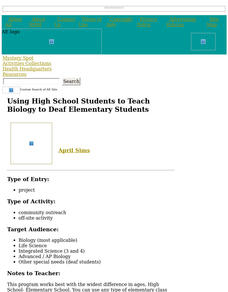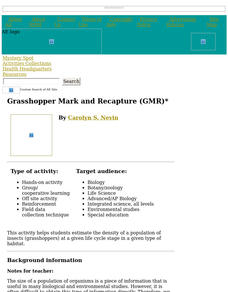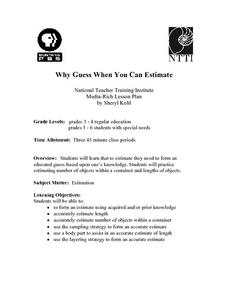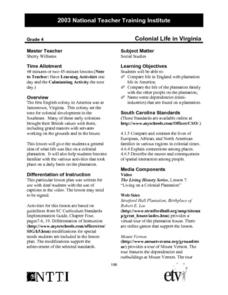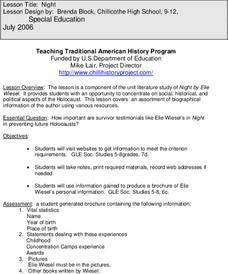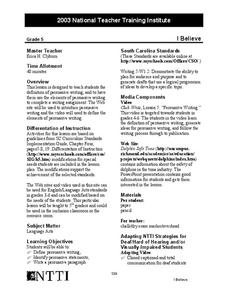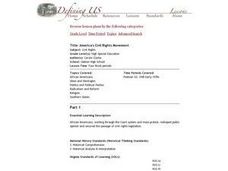Curated OER
Crustacean Critters
Young scholars explore the habitats of hermit crabs. In this crustacean lesson, students discover what animals need to survive. Working with live hermit crabs, young scholars explore how hermit crabs have adapted to their habitats.
Curated OER
Geometry Straws
Students create different angles and shapes by using different lengths of straws. For this geometry straws lesson plan, students glue straws onto paper and define what they have made.
Curated OER
Understanding and Supporting Our Peers with Cognitive Challenges
Young scholars explore different federal laws promoting the education for the handicapped. In this literacy lesson, students brainstorm how they can help individual with Down syndrome. They read a fiction book related to the topic and...
Curated OER
Using High School Students to Teach Biology to Deaf Elementary Students
Students teach Biology concepts to elementary students, in particular deaf students, by traveling once a month to the elementary classroom with activities / lessons that have been selected and prepared by the older students.
Curated OER
Grasshopper Mark and Recapture (GMR)
Learners estimate the density of a population of insects (grasshoppers) at a given life cycle stage in a given type of habitat.
Curated OER
Art for All
Students select objects and arrange them on a Plexiglas sheet and go into the darkroom in groups of two or three and create a photogram.
Curated OER
The Scientific Method (Senior, Science)
Student's recall from memory the steps in the scientific method. TSWBAT describe in detail the various steps of the scientific method. TSWBAT analyze a problem or situation and apply the steps of the scientific method to it.
Curated OER
Career Awareness on the Internet / Inspiration
Students choose an employment opportunity from a list of jobs. Next, students research their job and an employment application form on the Internet. With partners, students create journals describing the job qualifications, salaries, and...
Curated OER
Seasoning the School Year
Students observe the changes a class tree goes through as the seasons change and record observations in journals. They investigate changes in the weather, changes in the length of the day, and how that affects people. They create...
Curated OER
Why Guess When You Can Estimate
They apply various strategies in their estimations. They analyze the differences between guessing and estimating. They estimate the number of beans and jellybeans in egg cartons and jars respectively.
Curated OER
Gateway to America
Fifth graders study about immigration, Ellis Island, and tenement life from 1890 to 1924. They create an identity of a fictitious immigrant and describe what they find when they arrive in New York.
Curated OER
Colonial Life in Virginia
Fourth graders compare and contrast life in England with plantation life in America. They study the dependencies or mini-industries that could be found on plantations.
Curated OER
Immigrants: Yester and Today
Seventh graders brainstorm ideas why it is necessary to have a Resident Alien Id card. They complete a KWL chart on what they know about immigrants.
Curated OER
In Search of Afro-American Poets in Modern Times
Students develop an awareness of pride in the many contributions made by Afro-American poets. They gain an appreciation for poetry and express orally and in written form their feelings and emotions. They determine that poetry is age...
Curated OER
The Sounds of Samba
Students research the origins of Samba in Brazil using the internet. After defining new vocabulary, they locate the cities in Brazil using latitude and longitude which practice the Samba. In groups, they compare and contrast the...
Curated OER
Night
Students read Night by Elie Wiesel, examine importance of survivor testimonials like Wiesel's in preventing future Holocausts, research biographical information online about Wiesel, and create author brochure including vital statistics,...
Curated OER
Harp Of Gold
Students create "Harp" pictures using harp shapes, shoe box lids, paints, old sheet music, and inspiration from Harp music in this inter-disciplinary Art and Music activity for the elementary classroom. Resource links are included for...
Curated OER
I Believe
This lesson is designed to teach students the definition of persuasive writing, and to have them use the elements of persuasive writing to complete a writing assignment. The Web site will be used to introduce persuasive writing and the...
Curated OER
North Korea-A True Totalitarian Government
Ninth graders analyze the differences among various forms of government to determine how power is acquired and used. They need to have a strong background regarding the rise of totalitarian governments after The Great War and the...
Curated OER
Identifying Lines: Horizontal, Vertical, and Oblique
Second graders identify horizontal, vertical, and oblique lines on a worksheet after learning them in class. They demonstrate a horizontal line with their arms while saying the word and use their arms with no talking to demonstrate...
Curated OER
You Too Can Haiku
Students conduct Internet research and explain the history of Haiku. After listening and reading various examples of Haiku, students use their own vocabulary and practice their math skills to determine the correct number of syllables...
Curated OER
America's Civil Rights Movement
Eleventh graders explore, analyze and study the background to America's Civil Rights Movement through the court system, mass protest, public opinion, political cartoons and legislation. They research Rosa Parks, Brown vs. Board of...
National First Ladies' Library
"Just a Little Bit Different": Inclusive Classrooms, Inclusive Schools
Learners explore visible and invisible differences, those of language, religion, dress, ethnicity, gender, etc. with their classmates. They play Bingo with a created list of classroom differences. Afterward, they write a short paper...
Curated OER
Vocabulary Practice
In this vocabulary practice learning exercise, students choose the correct word out of the 2 words given that completes each of the following 16 sentences.





